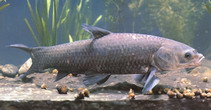Mylopharyngodon piceus (Richardson, 1846)
Black carp
Russian Federation country information
Common names:
Black amur, Chinese roach, Tschernyi Amur
Occurrence: native
Salinity: freshwater
Abundance: | Ref:
Importance: subsistence fisheries | Ref: Berg, L.S., 1964
Aquaculture: | Ref:
Regulations: | Ref:
Uses: no uses
Comments: Occurs in the Ussuri, Lake Khanka, and the Amur below Khabarovsk from the confluence of the Sungari to Novoil'inka and Lake Udyl (Ref. 26334). This has been translocated to areas within the country for aquaculture and stocking in open waters, but failed to establish populations (Ref. 45022). Native stocks have declined sharply (Ref. 59043). nEurRus
National Checklist:
Country Information: https://www.cia.gov/library/publications/resources/the-world-factbook/geos/rs.html
National Fisheries Authority:
Occurrences: Occurrences Point map
Main Ref: Bogutskaya, N.G. and A.M. Naseka, 1996
National Database:
Occurrence: native
Salinity: freshwater
Abundance: | Ref:
Importance: subsistence fisheries | Ref: Berg, L.S., 1964
Aquaculture: | Ref:
Regulations: | Ref:
Uses: no uses
Comments: Occurs in the Ussuri, Lake Khanka, and the Amur below Khabarovsk from the confluence of the Sungari to Novoil'inka and Lake Udyl (Ref. 26334). This has been translocated to areas within the country for aquaculture and stocking in open waters, but failed to establish populations (Ref. 45022). Native stocks have declined sharply (Ref. 59043). nEurRus
National Checklist:
Country Information: https://www.cia.gov/library/publications/resources/the-world-factbook/geos/rs.html
National Fisheries Authority:
Occurrences: Occurrences Point map
Main Ref: Bogutskaya, N.G. and A.M. Naseka, 1996
National Database:
Common names from other countries
分類 / Names 共通名の | 類義語 | Catalog of Fishes(部類, 種) | ITIS | CoL | WoRMS | Cloffa
> Cypriniformes (Carps) > Xenocyprididae (East Asian minnows)
Etymology: Mylopharyngodon: Greek, mylo = mill + Greek, pharynx = throat + Greek, odous = teeth (Ref. 45335).
More on author: Richardson.
Etymology: Mylopharyngodon: Greek, mylo = mill + Greek, pharynx = throat + Greek, odous = teeth (Ref. 45335).
More on author: Richardson.
Environment: milieu / climate zone / depth range / distribution range 生態学
; 新鮮な水; 汽水性の 底生の; pH range: 7.5 - 8.5; potamodromous (Ref. 51243); 深さの範囲 5 - 30 m (Ref. 6898). Subtropical; 0°C - 40°C (Ref. 55930); 53°N - 15°N, 100°E - 140°E (Ref. 55930)
分布 国々 | 国連食糧農業機関の区域 | エコシステム | 事件 | Point map | 導入 | Faunafri
Asia: Amur river basin to southern China (Ref. 55930). Reported from Vietnam (Ref. 44416). Persists only in Europe by stocking or accidental releases; native stocks in Russia have declined sharply (Ref. 59043). Several countries reported adverse ecological impact after introduction.
Length at first maturity / サイズ / 重さ / 年齢
Maturity: Lm 91.5, range 100 - ? cm
Max length : 180 cm TL オス/雌雄の選別がない; (Ref. 40637); common length : 12.2 cm SL オス/雌雄の選別がない; (Ref. 35840); 最大公表体重: 35.0 kg (Ref. 56557); 最大記録サイズ: 13 年 (Ref. 55930)
Max length : 180 cm TL オス/雌雄の選別がない; (Ref. 40637); common length : 12.2 cm SL オス/雌雄の選別がない; (Ref. 35840); 最大公表体重: 35.0 kg (Ref. 56557); 最大記録サイズ: 13 年 (Ref. 55930)
簡単な記述 検索表 | 形態学 | 形態計測学
背面の脊椎 (合計) : 0; 背鰭 (合計) : 7 - 9; 肛門の骨: 0; 臀鰭: 8 - 10. Anatomy of the pharyngeal apparatus is the main distinguishing characteristic; throat teeth typically form a single row of 4-5 large molariform teeth on each of the two arches, with formula typically 1,4 - 4,1.
Adults inhabit large lowland rivers and lakes, preferably with clear water and high oxygen concentrations. Larvae feed on zooplankton, then on ostracods and aquatic insects. At about 120 mm SL, juveniles start to prey on small snails and clams while larger juveniles and adults feed almost entirely on molluscs. Undertake upriver migration and spawns in open waters. Deposit pelagic or semipelagic eggs which hatch while drifting downstream. Larvae settle into floodplain lakes and channels with little or no current (Ref. 59043). Maximum age probably exceeds 15 years; the figure of 20 years is not supported by data (Ref. 55930).
Life cycle and mating behavior 成熟 | 繁殖 | 放精 | 卵 | 生産力 | 幼生
Prewspawning adults migrate upstream in spring - early summer; spawning takes place in turbulent waters; eggs are pelagic and drift downstream and larvae enter nursery areas such as flood plains or backwater habitats; main river channel is used as feeding and wintering area by subadults and adults.
主な参考文献
Upload your references | 参考文献 | コーディネーター | 協力者
Nico, L.G., J.D. Williams and H.L. Jelks, 2005. Black carp: biological synopsis and risk assessment of an introduced fish. American Fisheries Society, Bethesda, Maryland, USA. 337 p. (Ref. 55930)
Human uses
水産業: 高い商業の; 水産養殖: 商業
FAO(Aquaculture systems: 代謝; 水産業: 代謝; publication : search) | FishSource |
より多くの情報
Population dynamics
成長のパラメーター
Max. ages / sizes
Length-weight rel.
Length-length rel.
体長組成
Mass conversion
補充
豊度
成長のパラメーター
Max. ages / sizes
Length-weight rel.
Length-length rel.
体長組成
Mass conversion
補充
豊度
Anatomy
カマ
Brain
Otolith
カマ
Brain
Otolith
Physiology
Body composition
Nutrients
酸素消費
水泳形態
泳ぐ速さ
Visual pigments
Fish sound
Diseases & Parasites
Toxicity (LC50s)
Body composition
Nutrients
酸素消費
水泳形態
泳ぐ速さ
Visual pigments
Fish sound
Diseases & Parasites
Toxicity (LC50s)
用具
Bio-Quiz | E-book | 野外観察図鑑 | Length-frequency wizard | 生活史の基盤ツール | 目的のマップ | Classification Tree
| Catch-MSY |
特記事項
XMLをダウンロードして下さい
インターネットの情報源
Alien/Invasive Species database | Aquatic Commons | BHL | Cloffa | Websites from users | Check FishWatcher | CISTI | Catalog of Fishes(部類, 種) | DiscoverLife | ECOTOX | Faunafri | Fishtrace | GenBank(ゲノム, ヌクレオチド) | GloBI | GOBASE | | Google Books | Google Scholar | Google | IGFA World Record | MitoFish | 国のデーターベース | Otolith Atlas of Taiwan Fishes | PubMed | Reef Life Survey | Scirus | SeaLifeBase | 生命の木 | Wikipedia(行く, 検索する) | World Records Freshwater Fishing | 動物に関する記録
Estimates based on models
Phylogenetic diversity index (Ref. 82804): PD50 = 1.0000 [Uniqueness, from 0.5 = low to 2.0 = high].
Bayesian length-weight: a=0.00912 (0.00779 - 0.01068), b=3.09 (3.05 - 3.13), in cm Total Length, based on LWR estimates for this species (Ref. 93245).
栄養段階 (Ref. 69278): 3.2 ±0.44 se; based on food items.
回復力 (Ref. 120179): 低い, 4.5年~14年の倍増期間の最小個体群 (K=0.08-0.09; tm=3-9; tmax >13; Fec=1,000,000).
Fishing Vulnerability (Ref. 59153): Very high vulnerability (80 of 100).




